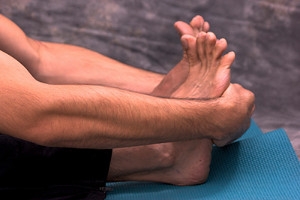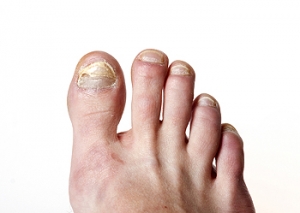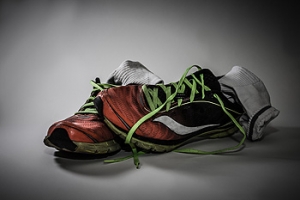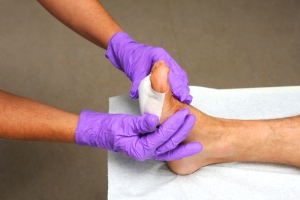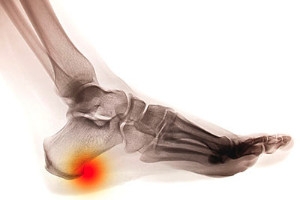Featured Articles
Super User
To Wear or Not To Wear High Heels
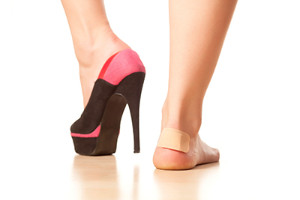 Wearing high heels may negate the fact that the feet act as shock absorbers. If proper shoes are worn, cushioning in the soles of the shoes generally protects the body from the constant battering incurred while walking and running. However, if the choice to wear high heels is made, the body’s weight shifts onto the balls of the feet, forcing the toes to be crammed into a small area and potentially resulting in all kinds of conditions. There are typically several reasons to avoid wearing high heels, one of which is abnormal movement occurring in the ankles. This can result from the foot being forced to bend forward, possibly restricting circulation in the feet. Additionally, the Achilles tendon is often affected which may cause pain in the calves. If high heels are consistently worn, the ankle and calf tendons may lose flexibility, making it difficult to walk. Good advice is to wear high heels as little as possible.
Wearing high heels may negate the fact that the feet act as shock absorbers. If proper shoes are worn, cushioning in the soles of the shoes generally protects the body from the constant battering incurred while walking and running. However, if the choice to wear high heels is made, the body’s weight shifts onto the balls of the feet, forcing the toes to be crammed into a small area and potentially resulting in all kinds of conditions. There are typically several reasons to avoid wearing high heels, one of which is abnormal movement occurring in the ankles. This can result from the foot being forced to bend forward, possibly restricting circulation in the feet. Additionally, the Achilles tendon is often affected which may cause pain in the calves. If high heels are consistently worn, the ankle and calf tendons may lose flexibility, making it difficult to walk. Good advice is to wear high heels as little as possible.
High heels have a history of causing foot and ankle problems. If you have any concerns about your feet or ankles, contact Dr. Dean D. Hinners from Illinois. Our doctor can provide the care you need to keep you pain-free and on your feet.
Effects of High Heels on the Feet
High heels are popular shoes among women because of their many styles and societal appeal. Despite this, high heels can still cause many health problems if worn too frequently.
Which Parts of My Body Will Be Affected by High Heels?
- Ankle Joints
- Achilles Tendon – May shorten and stiffen with prolonged wear
- Balls of the Feet
- Knees – Heels cause the knees to bend constantly, creating stress on them
- Back – They decrease the spine’s ability to absorb shock, which may lead to back pain. The vertebrae of the lower back may compress.
What Kinds of Foot Problems Can Develop from Wearing High Heels?
- Corns
- Calluses
- Hammertoe
- Bunions
- Morton’s Neuroma
- Plantar Fasciitis
How Can I Still Wear High Heels and Maintain Foot Health?
If you want to wear high heeled shoes, make sure that you are not wearing them every day, as this will help prevent long term physical problems. Try wearing thicker heels as opposed to stilettos to distribute weight more evenly across the feet. Always make sure you are wearing the proper shoes for the right occasion, such as sneakers for exercising. If you walk to work, try carrying your heels with you and changing into them once you arrive at work. Adding inserts to your heels can help cushion your feet and absorb shock. Full foot inserts or metatarsal pads are available.
If you have any questions please feel free to contact one of our offices located in Metropolis and Eldorado, IL . We offer the newest diagnostic and treatment technologies for all your foot and ankle needs.
Understanding Your Child’s Heel Pain
 Your child may experience heel pain during a growth spurt. This condition is commonly known as Sever’s disease. Since the heel grows faster than the rest of the leg, the tendons experience extra strain. Symptoms of Sever’s disease include pain in one or both of the heels, tenderness that increases during exercise, and trouble walking. Oftentimes, the best treatment is rest. The condition does not cause long-term issues and should subside after a few months. However, sometimes doctors will recommend that a child takes NSAIDs such as ibuprofen, performs stretching routines, and wears supportive shoes. Be especially cognizant for Sever’s disease if your child plays a sport that includes running or jumping on hard surfaces. If your child is experiencing heel pain, be sure to contact a podiatrist.
Your child may experience heel pain during a growth spurt. This condition is commonly known as Sever’s disease. Since the heel grows faster than the rest of the leg, the tendons experience extra strain. Symptoms of Sever’s disease include pain in one or both of the heels, tenderness that increases during exercise, and trouble walking. Oftentimes, the best treatment is rest. The condition does not cause long-term issues and should subside after a few months. However, sometimes doctors will recommend that a child takes NSAIDs such as ibuprofen, performs stretching routines, and wears supportive shoes. Be especially cognizant for Sever’s disease if your child plays a sport that includes running or jumping on hard surfaces. If your child is experiencing heel pain, be sure to contact a podiatrist.
Sever's disease often occurs in children and teens. If your child is experiencing foot or ankle pain, see Dr. Dean D. Hinners from Illinois. Our doctor can treat your child’s foot and ankle needs.
Sever’s Disease
Sever’s disease is also known as calcaneal apophysitis, which is a medical condition that causes heel pain I none or both feet. The disease is known to affect children between the ages of 8 and 14.
Sever’s disease occurs when part of the child’s heel known as the growth plate (calcaneal epiphysis) is attached to the Achilles tendon. This area can suffer injury when the muscles and tendons of the growing foot do not keep pace with bone growth. Therefore, the constant pain which one experiences at the back of the heel will make the child unable to put any weight on the heel. The child is then forced to walk on their toes.
Symptoms
Acute pain – Pain associated with Sever’s disease is usually felt in the heel when the child engages in physical activity such as walking, jumping and or running.
Highly active – Children who are very active are among the most susceptible in experiencing Sever’s disease, because of the stress and tension placed on their feet.
If you have any questions, please feel free to contact one of our offices located in Metropolis and Eldorado, IL . We offer the newest diagnostic and treatment technologies for all your foot and ankle injuries.
Walking Is a Successful Foot Stretch

Having strong feet is necessary for easily completing daily tasks. The feet carry the weight of the body, and many people understand the importance of maintaining foot strength and flexibility. Stretching and exercising the feet barefoot while indoors is helpful in noticing the muscles in the feet, and it can be pleasant to feel the floor while stretching. Walking is a great way to exercise all the foot muscles, tendons, and ligaments, in addition to lifting the feet and rotating the ankles several times. Building foot strength can be accomplished by lifting the toes while in a seated position and pressing on the floor, using the four corners of the foot. There are numerous types of stretches and exercises for the feet, and if you are interested in learning how to perform these, please consult with a podiatrist.
Why Stretching Is Important for Your Feet
Stretching the feet is a great way to prevent injuries. If you have any concerns with your feet consult with Dr. Dean D. Hinners from Illinois. Our doctor will assess your condition and provide you with quality foot and ankle treatment.
Stretching the Feet
Stretching the muscles in the foot is an important part in any physical activity. Feet that are tight can lead to less flexibility and make you more prone to injury. One of the most common forms of foot pain, plantar fasciitis, can be stretched out to help ease the pain. Stretching can not only ease pain from plantar fasciitis but also prevent it as well. However, it is important to see a podiatrist first to determine if stretching is right for you. Podiatrists can also recommend other ways to stretch your feet. Once you know whether stretching is right for you, here are some excellent stretches you can do.
- Using a foam roller or any cylindrical object (a water bottle or soda can will do), roll the object under your foot back and forth. You should also exert pressure on the object. Be sure to do this to both feet for a minute. Do this exercise three times each.
- Similar to the previous exercise, take a ball, such as a tennis ball, and roll it under your foot while seated and exert pressure on it.
- Grab a resistance band or towel and take a seat. If you are using a towel, fold it length wise. Next put either one between the ball of your foot and heel and pull with both hands on each side towards you. Hold this for 15 seconds and then switch feet. Do this three times for each foot.
- Finally hold your big toe while crossing one leg over the other. Pull the toe towards you and hold for 15 seconds. Once again do this three times per foot.
It is best to go easy when first stretching your foot and work your way up. If your foot starts hurting, stop exercising to ice and rest the foot. It is advised that you then see a podiatrist for help.
If you have any questions, please feel free to contact one of our offices located in Metropolis and Eldorado, IL . We offer the newest diagnostic and treatment technologies for all your foot care needs.
Stretching Your Feet
Debilitating foot pain is a problem for many people. But just as stretching the torso can help alleviate back pain, stretching the feet can also help mend existing foot problems and prevent future ones.
The feet, as the body’s foundation, carry the body’s entire weight and can get easily strained from overexertion. Persistent sharp pain and cramping in the feet are often common concerns. Foot pain and foot problems can be due to any number of causes, and in many cases pain may be eased without medication or doctor visits. It is always a good idea, however, to first rule out any serious medical issues with a physician.
Stretching can help relax the feet and alleviate pain, but is especially important before heavy aerobic exercise. Stretching before such activities can help you avoid experiencing painful cramps or strained foot muscles. Stretches should be performed slowly and deliberately without forceful pulling. The stretch should be held for several seconds before relaxing.
A great way to stretch out and loosen up the foot muscles while sitting is to cross one leg over the other and pull the toes carefully back without overextending. Start by resting the left ankle on the right knee. With the left hand, gently flex the left foot by pulling back on the toes. Do not pull too hard; just hard enough to feel the stretch in the arch of the foot. Then point the toes of the left foot as far as you can. Rotate the motion of pointing with pulling back on the toes. This should relax and stretch the muscles on the bottom and the top of the foot. Doing this stretch ten to twenty times should bring relief. Repeat the whole process for the other foot by resting the right ankle on the left knee.
A stretch that focuses on the often injured Achilles tendon involves standing and facing a wall with your arms out and hands flat against the wall. Step back with one foot, keeping it flat against the floor. Move the other leg forward and lean toward the wall. You should feel a stretch through the back of your leg and your Achilles tendon, but do not push yourself too much. Stop when you feel a stretching sensation, and hold for 30 seconds. Ten repetitions may be done for each foot.
Stretching the feet is important for athletes or those performing aerobic exercise, but it can also help anyone with foot pain caused by poor footwear, plantar fasciitis, or long hours standing and walking. Individuals who tend to their feet by regularly stretching every day should be able to minimize foot pain and prevent new problems from arising.
Preventive Measures for Plantar Hyperhidrosis
 There are numerous sweat glands in the body, also known as eccrine glands. When these glands are overactive, excessive sweating can come from the feet, which is a condition known as plantar hyperhidrosis. Numerous side effects may often accompany this ailment because the skin is consistently moist. These may include scaling of the feet, especially in between the toes. Additionally, inflammation of the skin, blisters, and itchy feet are among the many conditions that can occur from hyperhidrosis. If the type of footwear that is worn includes insulated or waterproof shoes, the feet can produce an abnormal amount of sweat resulting in discomfort. It’s important to choose shoes that allows the feet to breath, and this will generally help to control any excessive sweating that may occur. A consultation with a podiatrist may be suggested for information and advice on how to control plantar hyperhidrosis.
There are numerous sweat glands in the body, also known as eccrine glands. When these glands are overactive, excessive sweating can come from the feet, which is a condition known as plantar hyperhidrosis. Numerous side effects may often accompany this ailment because the skin is consistently moist. These may include scaling of the feet, especially in between the toes. Additionally, inflammation of the skin, blisters, and itchy feet are among the many conditions that can occur from hyperhidrosis. If the type of footwear that is worn includes insulated or waterproof shoes, the feet can produce an abnormal amount of sweat resulting in discomfort. It’s important to choose shoes that allows the feet to breath, and this will generally help to control any excessive sweating that may occur. A consultation with a podiatrist may be suggested for information and advice on how to control plantar hyperhidrosis.
If you are suffering from hyperhidrosis contact Dr. Dean D. Hinners of Illinois. Our doctor can provide the care you need to attend to all of your foot and ankle needs.
Hyperhidrosis of the Feet
Hyperhidrosis is a rare disorder that can cause people to have excessive sweating of their feet. This can usually occur all on its own without rigorous activity involved. People who suffer from hyperhidrosis may also experience sweaty palms.
Although it is said that sweating is a healthy process meant to cool down the body temperature and to maintain a proper internal temperature, hyperhidrosis may prove to be a huge hindrance on a person’s everyday life.
Plantar hyperhidrosis is considered to be the main form of hyperhidrosis. Secondary hyperhidrosis can refer to sweating that occurs in areas other than the feet or hands and armpits. Often this may be a sign of it being related to another medical condition such as menopause, hyperthyroidism and even Parkinson’s disease.
In order to alleviate this condition, it is important to see your doctor so that they may prescribe the necessary medications so that you can begin to live a normal life again. If this is left untreated, it is said that it will persist throughout an individual’s life.
A last resort approach would be surgery, but it is best to speak with your doctor to find out what may be the best treatment for you.
If you have any questions please feel free to contact one of our offices located in Metropolis and Eldorado, IL . We offer the newest diagnostic and treatment technologies for all your foot and ankle needs.
Common Symptoms of Toenail Fungus
 Toenails that are yellow and have become thick can be indicative of a condition that is known as toenail fungus. It is considered to be a fungal infection, and it is extremely contagious. It can be passed between people in warm and moist environments that can include public pools, communal shower room floors, and locker rooms. Methods can be implemented which can help to prevent spreading this condition. These methods can consist of wearing appropriate shoes while in these types of areas, and to avoid sharing shoes, socks, and towels. There are several remedies that may be effective in controlling toenail fungus. If you are afflicted with this condition, it is strongly suggested that you consult with a podiatrist who can discuss treatment options with you.
Toenails that are yellow and have become thick can be indicative of a condition that is known as toenail fungus. It is considered to be a fungal infection, and it is extremely contagious. It can be passed between people in warm and moist environments that can include public pools, communal shower room floors, and locker rooms. Methods can be implemented which can help to prevent spreading this condition. These methods can consist of wearing appropriate shoes while in these types of areas, and to avoid sharing shoes, socks, and towels. There are several remedies that may be effective in controlling toenail fungus. If you are afflicted with this condition, it is strongly suggested that you consult with a podiatrist who can discuss treatment options with you.
If left untreated, toenail fungus may spread to other toenails, skin, or even fingernails. If you suspect you have toenail fungus it is important to seek treatment right away. For more information about treatment, contact Dr. Dean D. Hinners of Illinois. Our doctor can provide the care you need to keep you pain-free and on your feet.
Symptoms
- Warped or oddly shaped nails
- Yellowish nails
- Loose/separated nail
- Buildup of bits and pieces of nail fragments under the nail
- Brittle, broken, thickened nail
Treatment
If self-care strategies and over-the-counter medications does not help your fungus, your podiatrist may give you a prescription drug instead. Even if you find relief from your toenail fungus symptoms, you may experience a repeat infection in the future.
Prevention
In order to prevent getting toenail fungus in the future, you should always make sure to wash your feet with soap and water. After washing, it is important to dry your feet thoroughly especially in between the toes. When trimming your toenails, be sure to trim straight across instead of in a rounded shape. It is crucial not to cover up discolored nails with nail polish because that will prevent your nail from being able to “breathe”.
In some cases, surgical procedure may be needed to remove the toenail fungus. Consult with your podiatrist about the best treatment options for your case of toenail fungus.
If you have any questions, please feel free to contact one of our offices located in Metropolis and Eldorado, IL . We offer the newest diagnostic and treatment technologies for all your foot care needs.
Blisters on the Bottom of the Feet

Blisters that form on the bottom of the feet can take the joy out of running, exercising, and participating in sporting activities. Blisters are common among athletes. So many seek to know their cause and how to care for them. A blister typically forms due to excessive friction from wearing shoes and socks that do not fit correctly. A bubble filled with liquid will form and remain that way until the raw skin underneath it has healed. Blisters on the bottom of the foot may heal faster when a gauze bandage is applied. The bandage can also provide the protection needed to avoid premature popping. Elevating the foot at the end of the day may be beneficial, as well as removing the bandage to allow air to reach the blister. Soaking the feet in warm water may help keep the blister clean, which can help to prevent an infection from developing. Blisters on the bottom of the feet can be bothersome, so if you are afflicted with one or more, please consult a podiatrist who can guide you toward the correct treatment.
Blisters are prone to making everyday activities extremely uncomfortable. If your feet are hurting, contact Dr. Dean D. Hinners of Illinois. Our doctor can provide the care you need to keep you pain-free and on your feet.
Foot Blisters
Foot blisters develop as a result of constantly wearing tight or ill-fitting footwear. This happens due to the constant rubbing from the shoe, which can often lead to pain.
What Are Foot Blisters?
A foot blister is a small fluid-filled pocket that forms on the upper-most layer of the skin. Blisters are filled with clear fluid and can lead to blood drainage or pus if the area becomes infected.
How Do Blisters Form?
Blisters on the feet are often the result of constant friction of skin and material, usually by shoe rubbing. Walking in sandals, boots, or shoes that don’t fit properly for long periods of time can result in a blister. Having consistent foot moisture and humidity can easily lead to blister formation.
Prevention & Treatment
It is important to properly care for the affected area in order to prevent infection and ease the pain. Do not lance the blister and use a Band-Aid to provide pain relief. Also, be sure to keep your feet dry and wear proper fitting shoes. If you see blood or pus in a blister, seek assistance from a podiatrist.
If you have any questions, please feel free to contact one of our offices located in Metropolis and Eldorado, IL . We offer the newest diagnostic and treatment technologies for all your foot care needs.
Is My Foot Pain an Ankle Sprain?
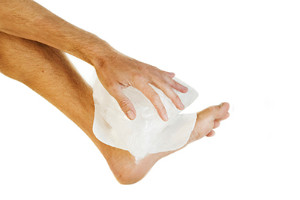 The overstretching and tearing of the ligaments around the ankle joint may often result in an ankle sprain. When the ankle suddenly moves out of its normal range of motion, the ligaments endure additional stress which may lead to a tear. This can be a common occurrence in sporting activities, but can also happen in everyday movements such as stepping off a curb. High-heel wearers also need to be careful, as tripping may be common due to unstable shoes. Immediate pain accompanied by tenderness is often felt because of the damage done to the ligaments. Swelling and bruising around the ankle is typical and may cause the ankle to feel unstable, resulting in difficulty walking. An MRI or X-ray is sometimes necessary in determining the severity of the sprain and in ruling out a possible fracture. Typically, elevating the foot and wearing ankle supports or braces may aid in reducing swelling, making the foot feel more comfortable. Please consult with a podiatrist immediately if you think you might have an ankle sprain.
The overstretching and tearing of the ligaments around the ankle joint may often result in an ankle sprain. When the ankle suddenly moves out of its normal range of motion, the ligaments endure additional stress which may lead to a tear. This can be a common occurrence in sporting activities, but can also happen in everyday movements such as stepping off a curb. High-heel wearers also need to be careful, as tripping may be common due to unstable shoes. Immediate pain accompanied by tenderness is often felt because of the damage done to the ligaments. Swelling and bruising around the ankle is typical and may cause the ankle to feel unstable, resulting in difficulty walking. An MRI or X-ray is sometimes necessary in determining the severity of the sprain and in ruling out a possible fracture. Typically, elevating the foot and wearing ankle supports or braces may aid in reducing swelling, making the foot feel more comfortable. Please consult with a podiatrist immediately if you think you might have an ankle sprain.
Ankle sprains are common but need immediate attention. If you need your feet checked, contact Dr. Dean D. Hinners from Illinois. Our doctor can provide the care you need to keep you pain-free and on your feet.
How Does an Ankle Sprain Occur?
Ankle sprains take place when the ligaments in your ankle are torn or stretched beyond their limits. There are multiple ways that the ankle can become injured, including twisting or rolling over onto your ankle, putting undue stress on it, or causing trauma to the ankle itself.
What Are the Symptoms?
- Mild to moderate bruising
- Limited mobility
- Swelling
- Discoloration of the skin (depending on severity)
Preventing a Sprain
- Wearing appropriate shoes for the occasion
- Stretching before exercises and sports
- Knowing your limits
Treatment of a Sprain
Treatment of a sprain depends on the severity. Many times, people are told to rest and remain off their feet completely, while others are given an air cast. If the sprain is very severe, surgery may be required.
If you have suffered an ankle sprain previously, you may want to consider additional support such as a brace and regular exercises to strengthen the ankle.
If you have any questions please feel free to contact one of our offices located in Metropolis and Eldorado, IL . We offer the newest diagnostic and treatment technologies for all your foot and ankle needs.
Keeping Pressure Off Foot Wounds
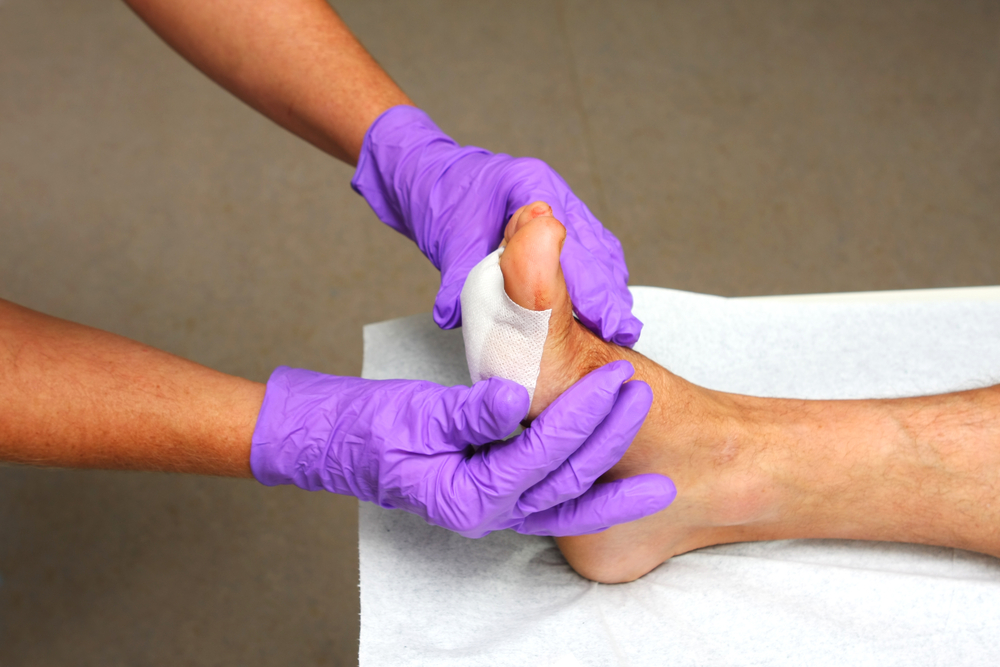 Wounds take time and attention to heal, especially when they are on the foot. Similar to injuries known as bedsores, wounds on the bottom of the feet are constantly under pressure. This pressure slows the healing process, because blood flow is weakened. Keeping pressure off the wound is essential in order to get the blood flowing back into the foot and facilitate the healing process. This can be done in easy ways, such as sitting or laying down. Standing directly on a wound probably causes some discomfort anyway, so giving it time to breathe is important. If you have an open wound on your foot and have additional questions, then it is recommended that you speak with a podiatrist to learn about the proper treatment options.
Wounds take time and attention to heal, especially when they are on the foot. Similar to injuries known as bedsores, wounds on the bottom of the feet are constantly under pressure. This pressure slows the healing process, because blood flow is weakened. Keeping pressure off the wound is essential in order to get the blood flowing back into the foot and facilitate the healing process. This can be done in easy ways, such as sitting or laying down. Standing directly on a wound probably causes some discomfort anyway, so giving it time to breathe is important. If you have an open wound on your foot and have additional questions, then it is recommended that you speak with a podiatrist to learn about the proper treatment options.
Wound care is an important part in dealing with diabetes. If you have diabetes and a foot wound or would like more information about wound care for diabetics, consult with Dr. Dean D. Hinners from Illinois. Our doctor will assess your condition and provide you with quality foot and ankle treatment.
What Is Wound Care?
Wound care is the practice of taking proper care of a wound. This can range from the smallest to the largest of wounds. While everyone can benefit from proper wound care, it is much more important for diabetics. Diabetics often suffer from poor blood circulation which causes wounds to heal much slower than they would in a non-diabetic.
What Is the Importance of Wound Care?
While it may not seem apparent with small ulcers on the foot, for diabetics, any size ulcer can become infected. Diabetics often also suffer from neuropathy, or nerve loss. This means they might not even feel when they have an ulcer on their foot. If the wound becomes severely infected, amputation may be necessary. Therefore, it is of the upmost importance to properly care for any and all foot wounds.
How to Care for Wounds
The best way to care for foot wounds is to prevent them. For diabetics, this means daily inspections of the feet for any signs of abnormalities or ulcers. It is also recommended to see a podiatrist several times a year for a foot inspection. If you do have an ulcer, run the wound under water to clear dirt from the wound; then apply antibiotic ointment to the wound and cover with a bandage. Bandages should be changed daily and keeping pressure off the wound is smart. It is advised to see a podiatrist, who can keep an eye on it.
If you have any questions, please feel free to contact one of our offices located in Metropolis and Eldorado, IL . We offer the newest diagnostic and treatment technologies for all your foot care needs.
Heel Spur Facts
A heel spur is a bony protruding outgr owth on the bone of the heel. They can be located either at the back of the heel or under it. Heel spurs located at the back of the heel are most often associated with inflammation of the Achilles tendon, which can cause tenderness and heel pain. Heel spurs will be diagnosed based on if you have a history of heel pain and if there is tenderness at the bottom of the heel. An X-Ray is typically required to confirm this. Some treatments for heel spurs include applying ice to the spot of the spur, orthotic devices or shoe inserts, anti-inflammatory medications such as Aleve and Advil, cortisone injections and sometimes surgery. Generally, heel spurs don’t lead to any long term conditions, as they usually respond well to the treatments mentioned previously. If you feel you may have developed a heel spur, it is advised that you go see a podiatrist.
owth on the bone of the heel. They can be located either at the back of the heel or under it. Heel spurs located at the back of the heel are most often associated with inflammation of the Achilles tendon, which can cause tenderness and heel pain. Heel spurs will be diagnosed based on if you have a history of heel pain and if there is tenderness at the bottom of the heel. An X-Ray is typically required to confirm this. Some treatments for heel spurs include applying ice to the spot of the spur, orthotic devices or shoe inserts, anti-inflammatory medications such as Aleve and Advil, cortisone injections and sometimes surgery. Generally, heel spurs don’t lead to any long term conditions, as they usually respond well to the treatments mentioned previously. If you feel you may have developed a heel spur, it is advised that you go see a podiatrist.
Heel spurs can be incredibly painful and sometimes may make you unable to participate in physical activities. To get medical care for your heel spurs, contact Dr. Dean D. Hinners from Illinois. Our doctor will do everything possible to treat your condition.
Heels Spurs
Heel spurs are formed by calcium deposits on the back of the foot where the heel is. This can also be caused by small fragments of bone breaking off one section of the foot, attaching onto the back of the foot. Heel spurs can also be bone growth on the back of the foot and may grow in the direction of the arch of the foot.
Older individuals usually suffer from heel spurs and pain sometimes intensifies with age. One of the main condition's spurs are related to is plantar fasciitis.
Pain
The pain associated with spurs is often because of weight placed on the feet. When someone is walking, their entire weight is concentrated on the feet. Bone spurs then have the tendency to affect other bones and tissues around the foot. As the pain continues, the feet will become tender and sensitive over time.
Treatments
There are many ways to treat heel spurs. If one is suffering from heel spurs in conjunction with pain, there are several methods for healing. Medication, surgery, and herbal care are some options.
If you have any questions feel free to contact one of our offices located in Metropolis and Eldorado, IL . We offer the latest in diagnostic and treatment technology to meet your needs.


